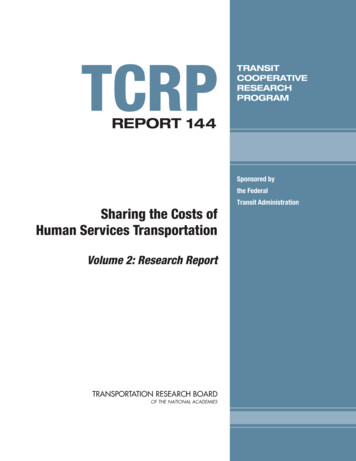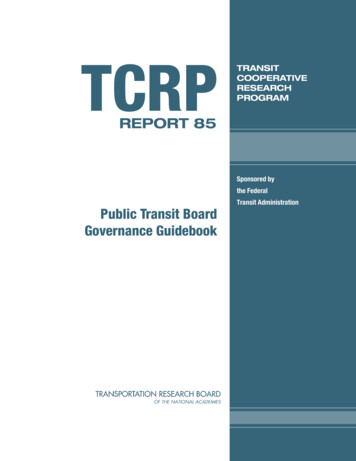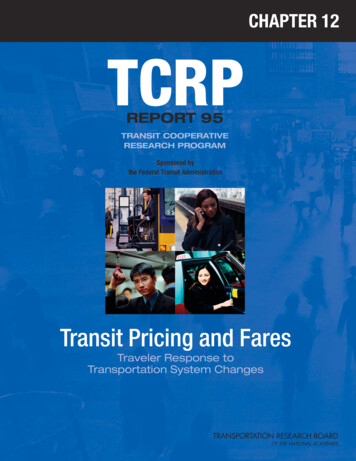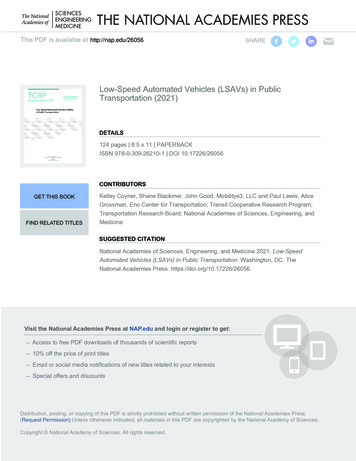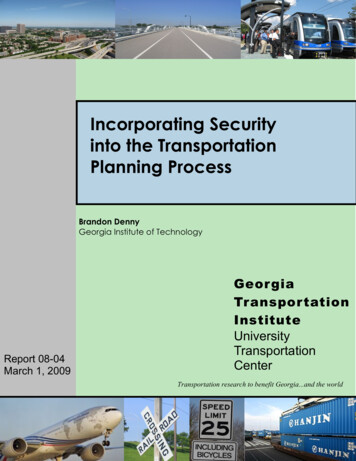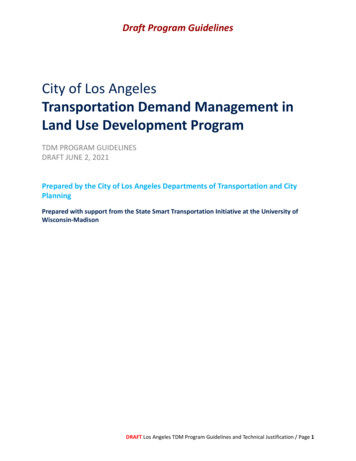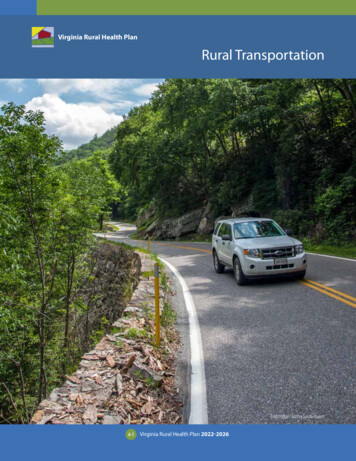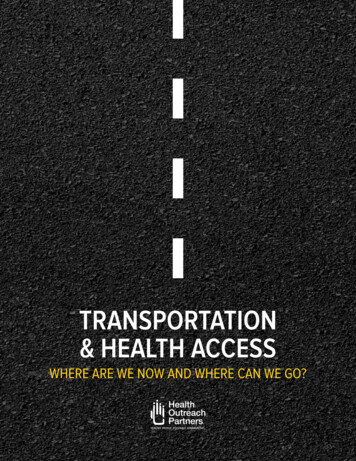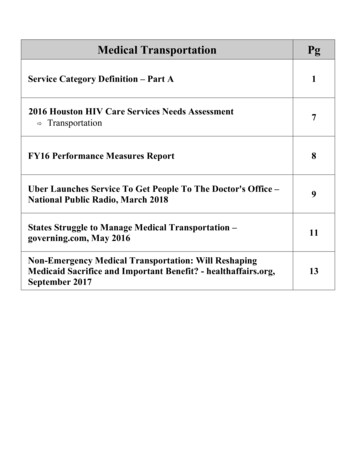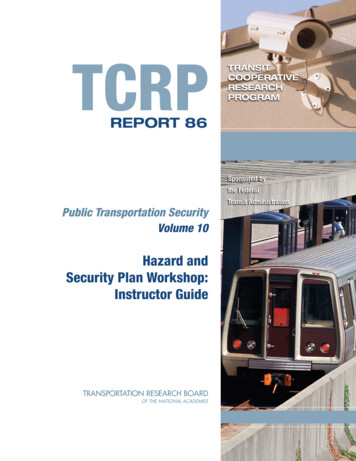
Transcription
RT 86Sponsored bythe FederaleTransitrAAdministrationPublic Transportation SecurityVolume 10Hazard andSecurity Plan Workshop:Instructor Guide
TCRP OVERSIGHT AND PROJECTSELECTION COMMITTEE(as of November 2005)TRANSPORTATION RESEARCH BOARD EXECUTIVE COMMITTEE 2005 (Membership as of November 2005)CHAIRDAVID A. LEEConnecticut TransitChair: John R. Njord, Executive Director, Utah DOTVice Chair: Michael D. Meyer, Professor, School of Civil and Environmental Engineering,Georgia Institute of TechnologyExecutive Director: Robert E. Skinner, Jr., Transportation Research BoardMEMBERSANN AUGUSTSantee Wateree Regional TransportationAuthorityLINDA J. BOHLINGERHNTB Corp.ROBERT I. BROWNSTEINPB Consult, Inc.PETER CANNITOMetropolitan Transportation Authority—Metro North RailroadGREGORY COOKAnn Arbor Transportation AuthorityNATHANIEL P. FORDMetropolitan Atlanta RTARONALD L. FREELANDBooz Allen Hamilton, Inc.FRED M. GILLIAMCapital Metropolitan Transportation AuthorityKIM R. GREENGFI GENFAREDAVID B. HORNERFTAJILL A. HOUGHNorth Dakota State UniversityJOHN INGLISHUtah Transit AuthorityJEANNE W. KRIEGEastern Contra Costa Transit AuthorityCELIA G. KUPERSMITHGolden Gate Bridge, Highwayand Transportation DistrictPAUL J. LARROUSSENational Transit InstituteCLARENCE W. MARSELLADenver Regional Transportation DistrictFAYE L. M. MOORESoutheastern Pennsylvania TransportationAuthorityMICHAEL H. MULHERNJacobs Civil Inc.STEPHANIE L. PINSONGilbert Tweed Associates, Inc.ROBERT H. PRINCE, JR.DMJM HarrisJEFFREY M. ROSENBERGAmalgamated Transit UnionMICHAEL SCANLONSan Mateo County Transit DistrictBEVERLY A. SCOTTSacramento Regional Transit DistrictKATHRYN D. WATERSDallas Area Rapid TransitFRANK WILSONMetropolitan Transit Authority of HarrisCountyEX OFFICIO MEMBERSWILLIAM W. MILLARAPTAROBERT E. SKINNER, JR.TRBJOHN C. HORSLEYAASHTOJ. RICHARD CAPKAFHWATDC EXECUTIVE DIRECTORLOUIS SANDERSAPTASECRETARYROBERT J. REILLYTRBOFFICERSMEMBERSMICHAEL W. BEHRENS, Executive Director, Texas DOTALLEN D. BIEHLER, Secretary, Pennsylvania DOTLARRY L. BROWN, SR., Executive Director, Mississippi DOTDEBORAH H. BUTLER, Vice President, Customer Service, Norfolk Southern Corporation and Subsidiaries,Atlanta, GAANNE P. CANBY, President, Surface Transportation Policy Project, Washington, DCJOHN L. CRAIG, Director, Nebraska Department of RoadsDOUGLAS G. DUNCAN, President and CEO, FedEx Freight, Memphis, TNNICHOLAS J. GARBER, Professor of Civil Engineering, University of VirginiaANGELA GITTENS, Vice President, Airport Business Services, HNTB Corporation, Miami, FLGENEVIEVE GIULIANO, Director, Metrans Transportation Center, and Professor, School of Policy,Planning, and Development, USC, Los AngelesBERNARD S. GROSECLOSE, JR., President and CEO, South Carolina State Ports AuthoritySUSAN HANSON, Landry University Professor of Geography, Graduate School of Geography, Clark UniversityJAMES R. HERTWIG, President, CSX Intermodal, Jacksonville, FLGLORIA JEAN JEFF, Director, Michigan DOTADIB K. KANAFANI, Cahill Professor of Civil Engineering, University of California, BerkeleyHERBERT S. LEVINSON, Principal, Herbert S. Levinson Transportation Consultant, New Haven, CTSUE MCNEIL, Professor, Department of Civil and Environmental Engineering, University of DelawareMICHAEL R. MORRIS, Director of Transportation, North Central Texas Council of GovernmentsCAROL A. MURRAY, Commissioner, New Hampshire DOTMICHAEL S. TOWNES, President and CEO, Hampton Roads Transit, Hampton, VAC. MICHAEL WALTON, Ernest H. Cockrell Centennial Chair in Engineering, University of Texas, AustinLINDA S. WATSON, Executive Director, LYNX—Central Florida Regional Transportation AuthorityEX OFFICIO MEMBERSMARION C. BLAKEY, Federal Aviation Administrator, U.S.DOTJOSEPH H. BOARDMAN, Federal Railroad Administrator, U.S.DOTREBECCA M. BREWSTER, President and COO, American Transportation Research Institute, Smyrna, GAGEORGE BUGLIARELLO, Chancellor, Polytechnic University, and Foreign Secretary, National Academyof EngineeringJ. RICHARD CAPKA, Acting Administrator, Federal Highway Administration, U.S.DOTTHOMAS H. COLLINS (Adm., U.S. Coast Guard), Commandant, U.S. Coast GuardJAMES J. EBERHARDT, Chief Scientist, Office of FreedomCAR and Vehicle Technologies, U.S. DOEJACQUELINE GLASSMAN, Deputy Administrator, National Highway Traffic Safety Administration, U.S.DOTEDWARD R. HAMBERGER, President and CEO, Association of American RailroadsDAVID B. HORNER, Acting Deputy Administrator, Federal Transit Administration, U.S.DOTJOHN C. HORSLEY, Exec. Dir., American Association of State Highway and Transportation OfficialsJOHN E. JAMIAN, Acting Administrator, Maritime Administration, U.S.DOTEDWARD JOHNSON, Director, Applied Science Directorate, National Aeronautics and Space AdministrationASHOK G. KAVEESHWAR, Research and Innovative Technology Administrator, U.S.DOTBRIGHAM MCCOWN, Deputy Administrator, Pipeline and Hazardous Materials Safety Administration, U.S.DOTWILLIAM W. MILLAR, President, American Public Transportation AssociationSUZANNE RUDZINSKI, Director, Transportation and Regional Programs, U.S. EPAANNETTE M. SANDBERG, Federal Motor Carrier Safety Administrator, U.S.DOTJEFFREY N. SHANE, Under Secretary for Policy, U.S.DOTCARL A. STROCK (Maj. Gen., U.S. Army), Chief of Engineers and Commanding General, U.S. Army Corpsof EngineersTRANSIT COOPERATIVE RESEARCH PROGRAMTransportation Research Board Executive Committee Subcommittee for TCRPJOHN R. NJORD, Utah DOT (Chair)DAVID B. HORNER, Federal Transit Administration, U.S.DOTMICHAEL D. MEYER, Georgia Institute of TechnologyWILLIAM W. MILLAR, American Public Transportation AssociationROBERT E. SKINNER, JR., Transportation Research BoardMICHAEL S. TOWNES, Hampton Roads Transit, Hampton, VAC. MICHAEL WALTON, University of Texas, AustinLINDA S. WATSON, LYNX—Central Florida Regional Transportation Authority
TRANSIT COOPERATIVE RESEARCH PROGRAMTCRP REPORT 86Public Transportation SecurityVolume 10Hazard andSecurity Plan Workshop:Instructor GuideAECOM CONSULT, INC.Fairfax, VAIn association withMAIER CONSULTING, INC.Barboursville, VAandPETER SCHAUER ASSOCIATESBoonville, MOS UBJECT A REASPlanning and Administration Public Transit SecurityResearch Sponsored by the Federal Transit Administration in Cooperation with the Transit Development CorporationTRANSPORTATION RESEARCH BOARDWASHINGTON, D.C.2006www.TRB.org
TRANSIT COOPERATIVE RESEARCH PROGRAMTCRP REPORT 86: Volume 10The nation’s growth and the need to meet mobility,environmental, and energy objectives place demands on publictransit systems. Current systems, some of which are old and in needof upgrading, must expand service area, increase service frequency,and improve efficiency to serve these demands. Research isnecessary to solve operating problems, to adapt appropriate newtechnologies from other industries, and to introduce innovations intothe transit industry. The Transit Cooperative Research Program(TCRP) serves as one of the principal means by which the transitindustry can develop innovative near-term solutions to meetdemands placed on it.The need for TCRP was originally identified in TRB SpecialReport 213—Research for Public Transit: New Directions,published in 1987 and based on a study sponsored by the Urban MassTransportation Administration—now the Federal Transit Administration (FTA). A report by the American Public TransportationAssociation (APTA), Transportation 2000, also recognized the needfor local, problem-solving research. TCRP, modeled after thelongstanding and successful National Cooperative HighwayResearch Program, undertakes research and other technical activitiesin response to the needs of transit service providers. The scope ofTCRP includes a variety of transit research fields including planning, service configuration, equipment, facilities, operations, humanresources, maintenance, policy, and administrative practices.TCRP was established under FTA sponsorship in July 1992.Proposed by the U.S. Department of Transportation, TCRP wasauthorized as part of the Intermodal Surface TransportationEfficiency Act of 1991 (ISTEA). On May 13, 1992, a memorandumagreement outlining TCRP operating procedures was executed bythe three cooperating organizations: FTA, The National Academies,acting through the Transportation Research Board (TRB); andthe Transit Development Corporation, Inc. (TDC), a nonprofiteducational and research organization established by APTA.TDC is responsible for forming the independent governing board,designated as the TCRP Oversight and Project Selection (TOPS)Committee.Research problem statements for TCRP are solicited periodicallybut may be submitted to TRB by anyone at any time. It is theresponsibility of the TOPS Committee to formulate the researchprogram by identifying the highest priority projects. As part of theevaluation, the TOPS Committee defines funding levels andexpected products.Once selected, each project is assigned to an expert panel,appointed by the Transportation Research Board. The panels prepareproject statements (requests for proposals), select contractors, andprovide technical guidance and counsel throughout the life of theproject. The process for developing research problem statements andselecting research agencies has been used by TRB in managingcooperative research programs since 1962. As in other TRB activities, TCRP project panels serve voluntarily without compensation.Because research cannot have the desired impact if products failto reach the intended audience, special emphasis is placed ondisseminating TCRP results to the intended end users of theresearch: transit agencies, service providers, and suppliers. TRBprovides a series of research reports, syntheses of transit practice,and other supporting material developed by TCRP research. APTAwill arrange for workshops, training aids, field visits, and otheractivities to ensure that results are implemented by urban and ruraltransit industry practitioners.The TCRP provides a forum where transit agencies cancooperatively address common operational problems. The TCRPresults support and complement other ongoing transit research andtraining programs.Project J-10DISSN 1073-4872ISBN 0-309-08848-8Library of Congress Control Number 2005938047 2006 Transportation Research BoardPrice 55.00NOTICEThe project that is the subject of this report was a part of the Transit CooperativeResearch Program conducted by the Transportation Research Board with theapproval of the Governing Board of the National Research Council. Suchapproval reflects the Governing Board’s judgment that the project concerned isappropriate with respect to both the purposes and resources of the NationalResearch Council.The members of the technical advisory panel selected to monitor this project andto review this report were chosen for recognized scholarly competence and withdue consideration for the balance of disciplines appropriate to the project. Theopinions and conclusions expressed or implied are those of the research agencythat performed the research, and while they have been accepted as appropriateby the technical panel, they are not necessarily those of the TransportationResearch Board, the National Research Council, the Transit DevelopmentCorporation, or the Federal Transit Administration of the U.S. Department ofTransportation.Each report is reviewed and accepted for publication by the technical panelaccording to procedures established and monitored by the TransportationResearch Board Executive Committee and the Governing Board of the NationalResearch Council.Special NoticeThe Transportation Research Board of The National Academies, the NationalResearch Council, the Transit Development Corporation, and the Federal TransitAdministration (sponsor of the Transit Cooperative Research Program) do notendorse products or manufacturers. Trade or manufacturers’ names appear hereinsolely because they are considered essential to the clarity and completeness of theproject reporting.Published reports of theTRANSIT COOPERATIVE RESEARCH PROGRAMare available from:Transportation Research BoardBusiness Office500 Fifth Street, NWWashington, DC 20001and can be ordered through the Internet rinted in the United States of America
The National Academy of Sciences is a private, nonprofit, self-perpetuating society of distinguished scholars engaged in scientific and engineering research, dedicated to the furtherance of science and technologyand to their use for the general welfare. On the authority of the charter granted to it by the Congress in1863, the Academy has a mandate that requires it to advise the federal government on scientific and technical matters. Dr. Ralph J. Cicerone is president of the National Academy of Sciences.The National Academy of Engineering was established in 1964, under the charter of the National Academy of Sciences, as a parallel organization of outstanding engineers. It is autonomous in its administrationand in the selection of its members, sharing with the National Academy of Sciences the responsibility foradvising the federal government. The National Academy of Engineering also sponsors engineering programsaimed at meeting national needs, encourages education and research, and recognizes the superior achievements of engineers. Dr. William A. Wulf is president of the National Academy of Engineering.The Institute of Medicine was established in 1970 by the National Academy of Sciences to secure theservices of eminent members of appropriate professions in the examination of policy matters pertainingto the health of the public. The Institute acts under the responsibility given to the National Academy ofSciences by its congressional charter to be an adviser to the federal government and, on its own initiative,to identify issues of medical care, research, and education. Dr. Harvey V. Fineberg is president of theInstitute of Medicine.The National Research Council was organized by the National Academy of Sciences in 1916 to associatethe broad community of science and technology with the Academy’s purposes of furthering knowledge andadvising the federal government. Functioning in accordance with general policies determined by the Academy, the Council has become the principal operating agency of both the National Academy of Sciencesand the National Academy of Engineering in providing services to the government, the public, and thescientific and engineering communities. The Council is administered jointly by both the Academies andthe Institute of Medicine. Dr. Ralph J. Cicerone and Dr. William A. Wulf are chair and vice chair,respectively, of the National Research Council.The Transportation Research Board is a division of the National Research Council, which serves theNational Academy of Sciences and the National Academy of Engineering. The Board’s mission is to promoteinnovation and progress in transportation through research. In an objective and interdisciplinary setting,the Board facilitates the sharing of information on transportation practice and policy by researchers andpractitioners; stimulates research and offers research management services that promote technicalexcellence; provides expert advice on transportation policy and programs; and disseminates researchresults broadly and encourages their implementation. The Board’s varied activities annually engage morethan 5,000 engineers, scientists, and other transportation researchers and practitioners from the public andprivate sectors and academia, all of whom contribute their expertise in the public interest. The program issupported by state transportation departments, federal agencies including the component administrations ofthe U.S. Department of Transportation, and other organizations and individuals interested in thedevelopment of transportation. www.TRB.orgwww.national-academies.org
COOPERATIVE RESEARCH PROGRAMS STAFF FOR TCRP REPORT 86, VOLUME 10ROBERT J. REILLY, Director, Cooperative Research ProgramsCHRISTOPHER W. JENKS, TCRP ManagerS. A. PARKER, Senior Program OfficerEILEEN P. DELANEY, Director of PublicationsANDREA BRIERE, EditorBETH HATCH, EditorTCRP PROJECT J-10DField of Special Projects—Area of SecurityRICHARD G. WONG, Rancho Santiago Community College District, Pasadena, CA (Chair)GERALD L. BLAIR, Indiana County Transit Authority, Indiana, PACHARLES CARR, Mississippi Department of TransportationPENELOPE J. PAGE, Yellow Connex, Baltimore, MDVINCENT P. PEARCE, U.S. Department of TransportationPATRICIA WEAVER, University of KansasRUTH O'HARA, FTA LiaisonGREG HULL, APTA LiaisonCHRISTOPHER A. KOZUB, National Transit Institute LiaisonCHRISTOPHER ZEILINGER, Community Transportation Association of America LiaisonJOEDY W. CAMBRIDGE, TRB LiaisonPETER SHAW, TRB LiaisonAUTHOR ACKNOWLEDGMENTSThe research reported herein was performed under TCRP ProjectJ-10D, “Developing and Updating Security Plans: A Pilot Coursefor Rural and Community-Based Public Transportation Systems,”by AECOM Consult, Inc., in conjunction with Maier Consulting,Inc., and Peter Schauer Associates.The TCRP panel defined the original objectives of the work andguided its completion.A particularly constructive role was played by the panel ofexperts who provided feedback regarding the needs of small systems in developing an appropriate security plan template. Thatpanel consisted of the following participants:Judge Kenton AskrenCircuit Court, Cooper County, Boonville, MissouriMr. Robert BorneCyRide, Ames, IowaMr. David BruffyMonongalia City Urban Mass Transit Authority, Morgantown,West VirginiaMr. Charles CarrMississippi DOTMs. Mona ComiciOATS West Regional Office, Sedalia, MissouriMr. David J. CusterCity of Morgantown Fire Department, Morgantown,West VirginiaMr. Kenneth LaRueOklahoma Transit Programs Division, Oklahoma City,OklahomaMs. Amanda RatliffDepartment of Homeland Security/Federal EmergencyManagement Agency Region VMr. J. R. SalazarCentral Texas Rural Transit, Coleman, TexasMr. John SorrellWiregrass Transit Authority, Dothan, AlabamaMr. Richard WongRancho Santiago Community College District, Pasadena,CaliforniaMr. Christopher ZeilingerCommunity Transportation Association of America,Washington, D.C.Pat Maier and Peter Schauer are co-principal investigators fromMaier Consulting, Inc., Barboursville, Virginia, and Peter SchauerAssociates, Boonville, Missouri, respectively. The other authors ofthis report are Scott Baker, vice president, and Vi Truong, lead consultant, both of AECOM Consult.Notwithstanding the generous contributions made by theresearch participants, errors and omissions remain the responsibility of the principal investigators.
FOREWORDBy S. A. ParkerStaff OfficerTransportation ResearchBoardThis tenth volume of TCRP Report 86: Public Transportation Security will assistrural, small urban, and community-based passenger transportation agencies in creatinghazard and security plans or evaluating and modifying existing plans, policies, and procedures consistent with the National Incident Management System (NIMS). Theimportance of NIMS is set out in a September 8, 2004, letter to state governors fromDepartment of Homeland Security Secretary Tom Ridge: “NIMS provides a consistentnationwide approach for Federal, State, territorial, tribal, and local governments towork effectively and efficiently together to prepare for, prevent, respond to, andrecover from domestic incidents, regardless of cause, size, or complexity.”Rural, small urban, and community-based passenger transportation agencies facemany of the same security concerns as other service-sector enterprises. Transit employees may experience workplace violence or spillovers of domestic violence, and thereis a risk of domestic or international terrorism. Beyond the immediate trauma of intentional harm to an employee, a destroyed vehicle, or a vandalized facility, there can bedisruptions to operations and emotionally disturbing repercussions to employees andpassengers that could shatter the functionality of the transit system. Consequently, transit systems must have a hazard and security plan in place, understood by all staff, toidentify and to eliminate the risk or minimize the loss and disruptions to operations,staff, and passengers.To accomplish the above tasks, rural, small urban, and community-based passenger transportation systems need practical planning templates that reflect the operatingenvironment and the realities of available staff for implementation. The templates mustbe flexible so they can be used in developing customized security plans and combinedwith effective training tools for each unique transit system. Hence, the objective of thisproject was to develop a hazard and security planning template and to design trainingfor developing security plans and integrating those plans into the routine of daily transit operations. Users of the TCRP Report 86 series will find that the products emphasize mitigation along with prevention, preparation, response, and recovery.The training course in this report is supplemented online with a downloadable template for a completed hazard and security plan. The CD-ROM includes those resourcesand more than 60 other documents organized in an electronic library.AECOM Consult prepared this volume of TCRP Report 86 under TCRP Project J-10D.Emergencies arising from terrorist threats highlight the need for transportationmanagers to minimize the vulnerability of travelers, employees, and physical assetsthrough incident prevention, preparedness, mitigation, response, and recovery. Managers seek to reduce the chances that transportation vehicles and facilities will be targets or instruments of terrorist attacks and to be prepared to respond to and recover fromsuch possibilities. By being prepared to respond to terrorism, each transportation
agency is simultaneously prepared to respond to natural disasters such as hurricanes,floods, and wildfires, as well as human-caused events such as hazardous materials spillsand other incidents.This is the tenth volume of TCRP Report 86: Public Transportation Security,a series in which relevant information is assembled into single, concise volumes—eachpertaining to a specific security problem and closely related issues. These volumesfocus on the concerns that transportation agencies are addressing when developing programs in response to the terrorist attacks of September 11, 2001, and the anthrax attacksthat followed. Future volumes of the reports will be issued as they are completed.To develop this volume in a comprehensive manner and to ensure inclusion ofsignificant knowledge, available information was assembled from numerous sources,including a number of state departments of transportation. A topic panel of experts inthe subject area was established to guide the researchers in organizing and evaluatingthe collected data and to review the final document.This volume was prepared to meet an urgent need for information in this area.It records practices that were acceptable within the limitations of the knowledge available at the time of its preparation. Work in this area is proceeding swiftly, and readersare encouraged to be on the lookout for the most up-to-date information.Volumes issued under TCRP Report 86: Public Transportation Security maybe found on the TRB website at http://www.TRB.org/SecurityPubs.
CONTENTS1Using the Instructor Guide1Preface3Introduction and Background4Course Goals4General Instructional Approach5Conceptual Agenda and Elapsed Times7Workshop Outline10Template for a 1-Day Workshop11Template for a 2-Day Workshop12Materials, Audio Visual, and Miscellaneous Requirements14Participant Agenda18Before Presenting the Course: A ChecklistAt-1ATTACHMENT 1 Volunteer Fire Departments (VFDs) andTerrorism AnalogsA-1APPENDIX ALesson PlanB-1APPENDIX BInstructor PowerPoint Slides and NotesC-1CD Contents
Using the Instructor GuideImportant: Read through the entire instructor package and pay special attention to the lesson plan.Carefully read the notes accompanying the training slides and study the participant hazard and securityplan (HSP) template. It is estimated that, for an expert trainer, a minimum of 16 hours of preparationare required for delivering the course the first time. If you are not an expert trainer, it may take youlonger to prepare for the course the first time you present it. As a trainer becomes more familiar withthe flow and content, preparation times will diminish, but every instructor should spend some timepreparing his or her presentation. Good luck and safe and happy training!PrefaceThis instructor guide contains the materials for facilitating and guiding the HSP workshop. This guidecontains: The instructor guide with instructions on how to present the course. The lesson plan. The instructor PowerPoint presentation with notes. The workshop participant guide (which is the PowerPoint presentation slides in a “three-up”format), the HSP Instructions, the HSP template, and an agenda.The CD-ROM contains the template that participants will adapt for their organizations and samplepolicies and procedures that can be used as resource materials. This CD-ROM must be duplicated insufficient quantity so each student gets one copy with their “hard copy” template. The CD-ROM alsocontains all the materials in an electronic format for preparation of workshop materials and thePowerPoint presentation.The purpose of the workshop is to have participants take notes on the HSP template so that when theyreturn to their office, they can quickly complete their own plan. When participants leave the workshop,they should feel they have a draft plan in hand that they will refine at their office.The workshop has many goals, and as the instructor it is your duty to: Help workshop participants overcome any resentment they may have to the concept of an HSP. Help workshop participants achieve a working knowledge of common security and hazard terms. Help workshop participants understand what their role is in the range of security and hazardincidents and build confidence that they can respond competently by completing an HSP. Foster a sense of community and helping among workshop participants. Ensure that workshop participants take notes on their template and know how to edit and preparethe CD-ROM for finalizing their own plan.1
By thoroughly studying the instructor guide and slide discussion notes you will be prepared to achieveall the above goals. Should any instructor using these materials feel the need for more backgroundmaterial or encouragement on meeting the above goals, contact:Stephan Parker, Senior Program OfficerTransportation Research Board, Cooperative Research ProgramsEmail: saparker@nas.edu or Telephone 202-334-2554www.trb.org/securitypubs2
Introduction and BackgroundHazard and Security Planning: “One size does not fit all!”Rural, small urban, and community-based public transportation agencies face many of the samesecurity concerns as other service-sector enterprises. Transit employees may experience workplaceviolence or spillovers of domestic violence, and there is a risk of domestic or international terrorism.Beyond the immediate trauma, intentional harm to an employee, a destroyed vehicle, or a vandalizedfacility can be disruptive to operations and emotionally disturbing to employees and riders. Consequently,transit systems must have a plan to identify and to eliminate the risk of these events or mitigate the loss.Rural, small urban, and community-based public transportation systems do not generally havesufficient staffing and funding resources to develop and apply the type of system security plans thatmay be generated and used in larger urban areas.Yet, as security planning becomes a requisite element of transit management across the United States,researchers are discovering that one size does not fit all. In some respects, security and hazard planningcan vary more between Bonifay, Florida, and Boonville, Missouri, than between New York and LosAngeles. What researchers have found is that in rural areas there are wide varieties of hazards andsecurity threats ranging from nuclear bomb disposal in rural Texas to large earthen dams in Pennsylvaniato tsunamis in Hawaii. It can be said that urban security needs are more similar and more predictablethan those in the rural portions of our country, where safety and security threats, ranging from modestto extreme, may develop from circumstances unknown in urban areas. Consequently, security planningfor rural areas does not fit neatly into prevention and response patterns established in urban areas.To help overcome this variability in security and hazard planning for rural, small urban, andcommunity-based transportation, the malleable “hazard and security plan” (HSP) template wasdeveloped under Project J-10D, “Security Planning Tools for Rural, Small Urban, and CommunityBased Public Transportation Operations,” for the Transit Cooperative Research Program. The HSPtemplate should help rural, small urban, and community-based transit managers select policies andprocedures that fit the individual needs of each service area. The template is introduced in an 8-hourworkshop. During the workshop, participants are guided through the template in an interactive processto help participants establish the foundation of the plan so they can return to their home office tocomplete and refine the document for use. Recognizing that rural, small urban, and community-basedtransit managers “wear many hats” in their organizations, the template is designed to be comprehensiveand thorough, yet also adaptable and not burdensome. A CD-ROM containing the plan template andsample policies is given to each participant with the workshop materials.An important feature of the workshop, designed to help participants understand the nature of theirhazard and security threats, is the preparation of an area base map, similar to the map shown on Slide68. Workshop participa
ANGELA GITTENS, Vice President, Airport Business Services, HNTB Corporation, Miami, FL GENEVIEVE GIULIANO, Director, Metrans Transportation Center, and Professor, School of Policy, . Jacobs Civil Inc. STEPHANIE L. PINSON Gilbert Tweed Associates, Inc. ROBERT H. PRINCE, JR. . training programs. TCRP REPORT 86: Volume 10 Project J-10D ISSN .
